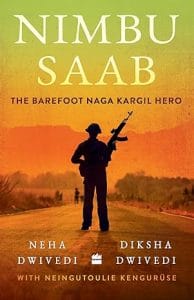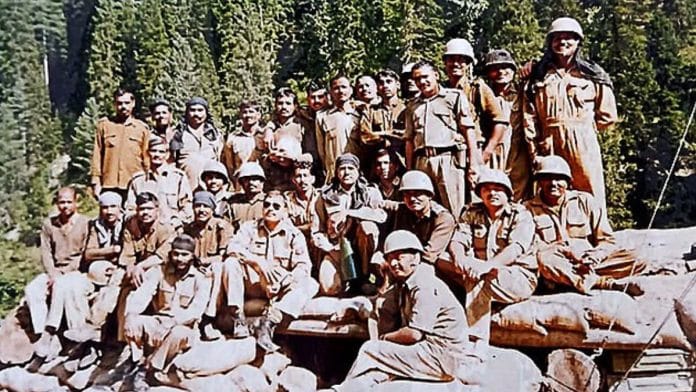By the time Neibu had reached the unit, Tomar and Thapar were already staying in the lines and Neibu joined them. The distribution of Companies worked out very well for Neibu as well, since the one he was assigned to was made up of troops (Rajputs) who would eat meat, as opposed to the Jat troops, who didn’t.
In any case, Neibu did not really face any issues adjusting to his new surroundings. Those who believe in destiny may think that growing up in a large family living in a small house was perhaps God’s way of preparing him for his destiny—for his days in the army. In fact, many of the other men too came from backgrounds similar to our Neibu’s, so relating to them was easy for Neibu.
However, there was one hiccup. Though a year and a half of academy training had made Neibu comfortable with conversing in Hindi, none of the officers and men had any experience with the Naga language. Therefore, just as it had been in the academy, most people struggled with his first name, Neikezhakuo. So, while the officers settled for Neibu, which was much easier to pronounce, the men gave him a name that rolled off their tongues much more easily. And that is how Neibu became the much-loved Nimbu Saab!
The life of a newly commissioned officer in the unit is rigorous, to say the least. If anyone had ever thought that after the hard and tiring life of the academy, he would enjoy a better one as a commissioned officer, he would be in for a rude shock.
Mornings began as early as 5 a.m. in the lines, and even in the cold months of December and January, there was no geyser or water heater, so everyone had to take a bath with cold water. That was the downside of getting commissioned in the winters as opposed to summers. The routine was the same for everyone living in the lines.
Also read: Love in the times of Kargil War, Army tales & traditions at a Delhi book launch
After the cold-water bath, they all had to rush for ‘muster’ fall in, followed by PT. Once the PT was over, depending on whether any of them were called aside by the adjutant (an appointment in the unit) or the CHM (a Company Havaldar Major), they would head back to the lines by 7 a.m. Then again, they had to change, get dressed, go to the langar (army kitchen) to eat and leave to be on parade duty by 8.15 or 8.30 a.m.
They broke off for lunch around 1 or 1.30 p.m., went to the langar to eat and back to the lines to rest for the little time they could manage. The rest period usually didn’t last for long since they were required to change and turn up for evening games again at 4 or 4.30 p.m. (The weather played spoilsport in the winter, when days were shorter, so the games were at 4 p.m. in wintertime.)
The games would conclude by 5 p.m. or so, and again the young officers needed to be back at the office to complete various tasks allotted to them till around 7 p.m. However, for at least one of them, the day would still not be over as they were assigned guard duty, on a rotational basis, to cover the late hours of the night.
Adding to all the above, at the time of their joining, the unit was preparing for a cross-country run, and all three new officers were put in the cross-country team. This added more time to their physical training since, in essence, now they were going for a 10-kilometre run during both halves of the day.
However, physical training was the least of Neibu’s worries, since the unit was gearing up for one of the most-awaited events to take place every time a new officer joins it: the dining in.
Typically, the dining in is supposed to be a formal dinner, welcoming the new ‘baby of the regiment’, where he gets a chance to meet all the officers and their families, who are also invited for the dining in, to the mess. While the idea is to break the ice for and with the new officer joining the unit, a dining in usually involves much more for the young officers in question.
Usually, different units have different dining in traditions, but the one thing that is common to most is the punch that they prepare and that is to be had by the new officer in one go. The punch drinking typically has the desired effect of getting the inhibitions of the new officer lowered, enabling everyone to indulge in a carefree manner. The ritual often leads to stories that are fondly recounted for years and years to come, often embarrassing the person in question.
The dining in organized for Neibu, Tomar and Thapar was no exception. The fact that the three of them had varying alcohol intake thresholds made the evening even more interesting. Neibu and Thapar being complete teetotalers were the first to get completely inebriated. Neibu had never even tasted alcohol before, and so he really was the first one to get sloshed, followed soon enough by Thapar.
Within the next few minutes, both of them were found sitting in the dried-up drain outside the officers’ mess, cursing the rest of the officers for getting them drunk, saying, ‘Jesus Christ will not forgive you, for you have made us sin!’ Tomar, on the other hand, was a seasoned player and could hold his drinks better. As a result, the evening ended with the mess running out of the alcohol and Tomar helping both his course mates get back to their beds by 3.30 a.m.!
 This excerpt from ‘Nimbu Saab: The Barefoot Naga Kargil Hero’ by Neha Dwivedi and Diksha Dwivedi with Neingutoulie Kenguruse has been published with permission from HarperCollins Publishers.
This excerpt from ‘Nimbu Saab: The Barefoot Naga Kargil Hero’ by Neha Dwivedi and Diksha Dwivedi with Neingutoulie Kenguruse has been published with permission from HarperCollins Publishers.






